Date: 2016
Elaborated by the cattle breeding group of the Swiss Biodynamic Association and FiBL.
There is hardly an animal organ which is so widely discussed as the cow horn. It is both fascinating and disturbing. Many cows no longer have horns because either they have been disbudded as calves or the growth of horns has been bred out of them.
Before deciding to embark on such an invasive procedure we should surely understand what horns mean for the cow. This booklet seeks to shed light on the issue by bringing together some basic facts and observations.
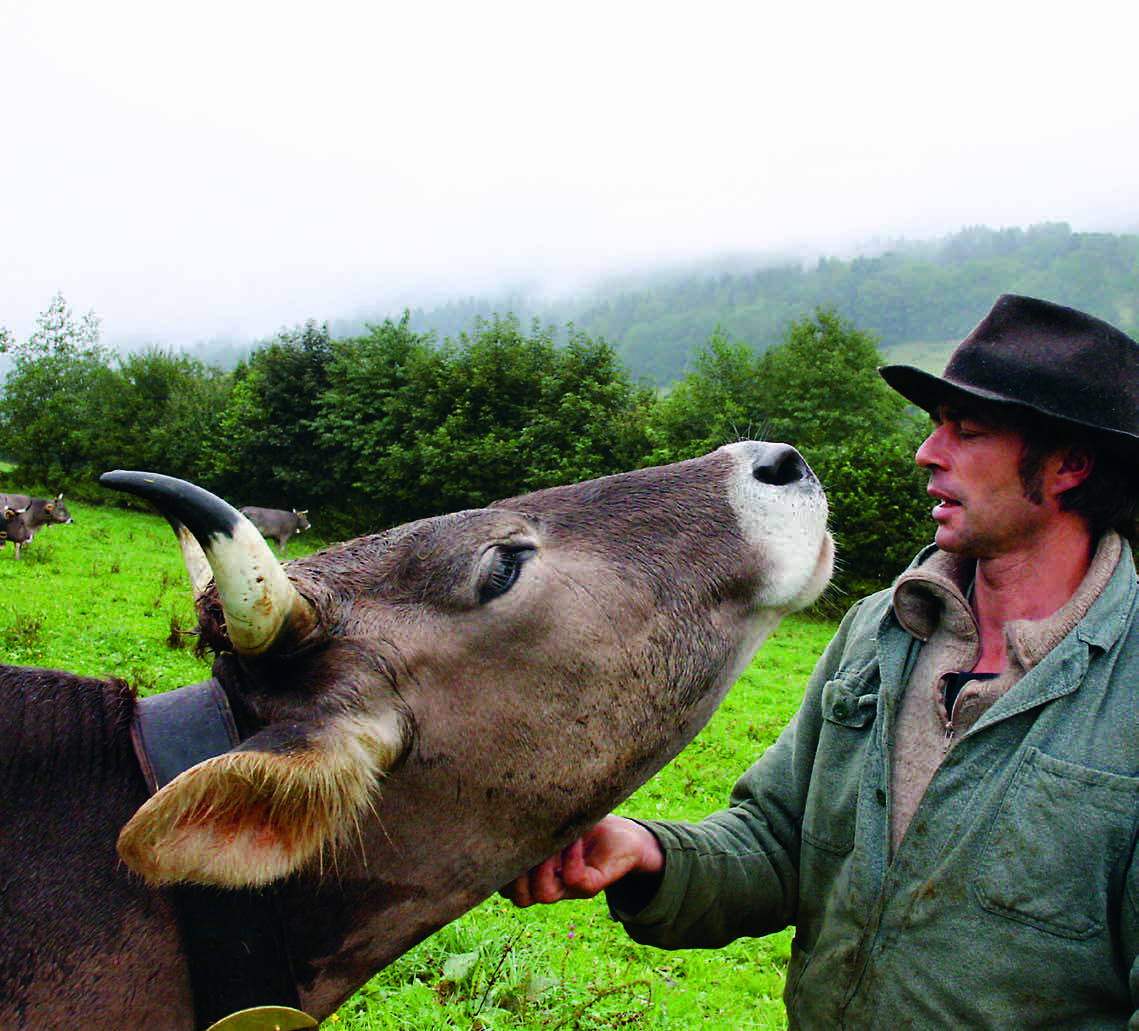
Dehorning re-assessed
Organic farms aim to minimise their interventions on animals as do the organic regulations in the EU and the regulations of IFOAM. Today however at least three out of four calves born on organic farms are dehorned. The dehorning of adult animals on organic farms in the EU and Switzerland is forbidden.
The Code of Recommendations for the Welfare of Livestock of the United Kingdom states that under the Protection of Animals Act 1954 it is an offence to disbud calves or dehorn cattle without the use of an anaesthetic, unless chemical cauterisation is used within the first week of life. However, this procedure is not recommended. Instead, it is recommended to disbud calves within their first two months of life with a heated iron under local anaesthetic by a trained and competent stockkeeper.
Dehorning makes it easier to keep cattle in loose housing with limited space and reduces the danger of injuries. In loose housing that is set up to cater for cows with horns however, injuries rarely occur. FiBL's booklet on appropriate housing for horn bearing dairy cows (in 2016 available in German only) summarises the experiences to date and makes recommendations.
The breeding of hornless animals offers an alternative to de-horning. Because «hornless» is genetically dominant over «horned», it is possible to breed out the horns of our common breeds of cattle fairly quickly.
Before robbing all cows of their horns for utilitarian reasons however, it would be worth finding out what significance a cow's horns might have. Since this theme has not been researched very much until now, biodynamic farmers working with researchers from FiBL have brought together and interpreted their observations and pictures of the anatomy, physiology and biological development of the horns as well as their functions.
The nature of horned animals
Horned animals possess several unique features. If we look at an animal with two symmetrically placed horns on its head, we know that it is a ruminant with a differentiated metabolic system, four stomachs and a long intestine. Digestion and metabolism play a central role in its life.
Ruminants live primarily on grass, hay or leaves. They need less energy to break down and transform cellulose material than any other animal. Nor can it be more efficiently achieved using technology.
We find neither canine teeth nor incisors in the upper jaws of ruminants. Although present in earlier embryonic stages they are re-absorbed before breaking through the gums. Instead the gums form a hardened dental plate with a horn-like surface. In the lower jaw the canine is formed like a fourth incisor. The teeth are dominated by the large molars which are used for chewing roughage.
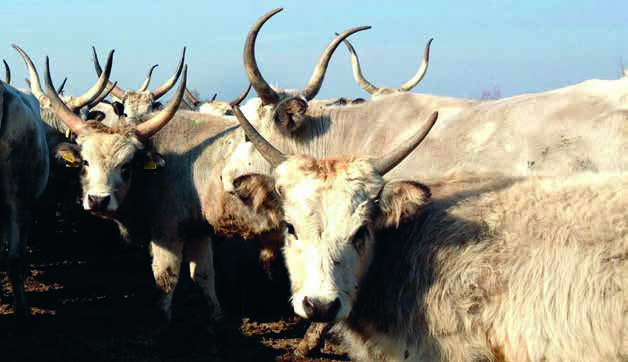
Hungarian Steppe Cattle on a farm in Ukraine.
Ruminants are even-toed ungulates with always a pair of hooves (cloven hooves) at the end of their limbs and two small dewclaws. Ruminants are also herd animals.
Calves of ruminants are born fully developed. Within a few hours they are able to stand up and suckle independently. To begin with the abomasum (fourth stomach) of the calf grows more quickly than the other stomachs. As soon as it starts eating roughage (which thanks to the fully developed milk teeth is already possible after a few days), the fore stomachs grow and can reach in an adult cow a capacity of 120 litres.
Cattle grow relatively slowly in comparison with other mammals and therefore do not require concentrated protein. This is why the protein content of cow's milk is not particularly high.
The placenta of the ruminant is not only connected with the uterus in one place as it is with humans, but across the entire surface of the foetal membrane with around 70 rose-like caruncles (placentomes). There are many layers of cells lying between the embryonic and maternal blood vessels. It is not made easy for the embryo to come by nourishment and oxygen - a preparation perhaps for dealing with hard-to-digest cellulose later on?
The position of cattle among the hoof animals
The horn bearing animals stand at the end of a long line of development which began millions of years ago. Animals with hooves (ungulates) are generally strong in their metabolism and limbs. They are therefore at the opposite end of the spectrum to rodents for whom nerve-sense activity is the focus. The carnivores share both qualities but to a lesser degree - they lie in between. The following diagram distinguishes the more nerve-sense focused hoof animals (blue lines) from the more metabolism focused ones (red lines) and in doing so reveals the polarity which can be so often found in the world of animals. The horn bearing animals and cattle having the most strongly developed metabolism are found at the end of all the metabolism focused lines.
Horn bearing animals within the group of ungulates (according to Wolfgang Schad)
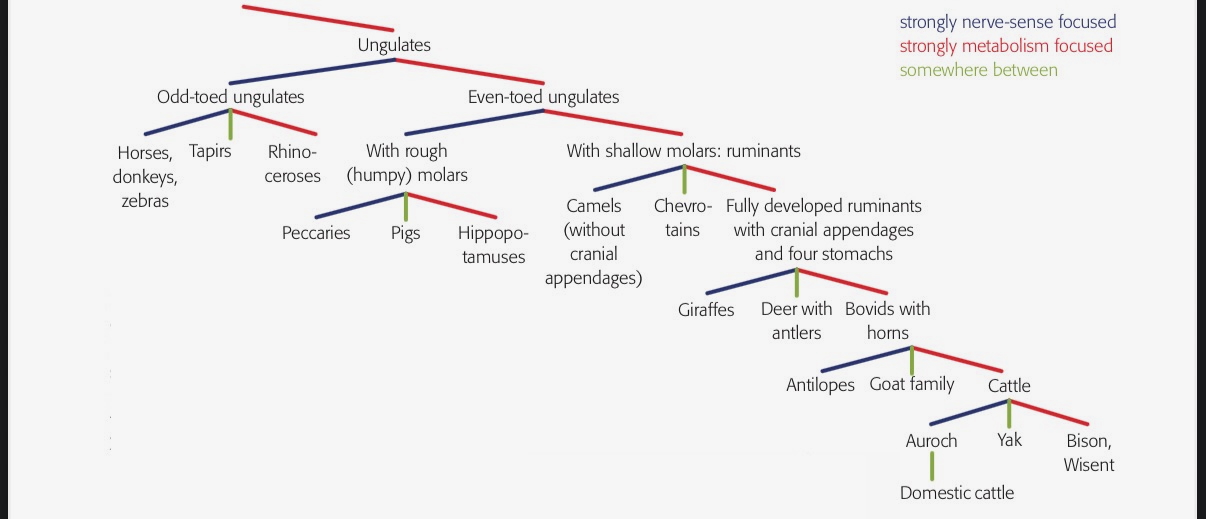
The horns of cows ascend upwards like the human head - an individualising tendency. It has to do with dignity, value and self-determination. A cow with horns has more of this quality than one without. - Andi Wälle, farmer
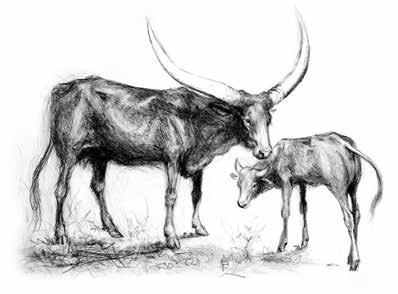
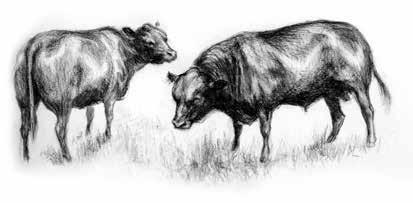
The differences could hardly be more pronounced. The Texan Longhorns, Hungarian Steppe Cattle and African breeds like the Watussi Cattle (drawing above) have enormous horns and seemingly emaciated bodies.
Hornless breeds like the Aberdeen Angus (drawing below), Galloway and Fjäll cattle on the other hand have markedly compact bodies.
From the perspective of morphic biology a clear correlation can be found between the form of the body and that of the horns. The body and horns seem to compensate for one another - the slimmer the body the larger the horn; the more stocky the body the less horn there is.
-
Species within the cattle family such as the domestic cow, bison, buffalo and wisent are notably more weighty in the fore part of the body due the size of the forestomachs (pregnancy and the production of milk can override this impression in female animals).
-
Members of the cattle family living in cooler regions tend to have smaller horns or none at all. Their body structure is denser and more weight is carried on the front legs.
-
Cattle in southerly regions have larger horns and a slimmer body that is less weighted towards the front. ^1
-
Animals living under more sparse feeding conditions have larger horns, while those living where it is more lush tend to have smaller ones. ^1
-
Animals living in the tropics have larger and much thinner horns than those from temperate zones. Research shows that in the tropical climate horns can also help to regulate body tmperature. ^1
In the case of the antelope and goat species the slimmer body type is more dominant. The head is smaller and more upright and the horns grow more steeply and are set further forward on the skull.
^1 According to scientific literature, available from the authors.
Although all mammals possess the same basic organs there is great variation in the degree to which they have been developed. One organ may develop strongly at the expense of another. This can be seen most clearly in the teeth.
-
It is only in ruminants that the canine and incisor teeth are replaced by a horny dental plate in the upper jaw. The first intake of food through the mouth of a ruminant is relatively unimportant; the real work is carried out in the rumen and by the large molars when ruminating.
-
The nerve-sense focused rodent species have continually growing incisors.
-
With the carnivores it is the large canine teeth and sharp molars used for tearing flesh that predominate.
The development of horns and antlers always seems to occur at the expense of the teeth. This points towards a connection between the horns and the metabolic system, although this is not immediately visible.
Differences between male and female animals of the same species can also be seen - these are even more visible in wild animals.
-
The bull carries a disproportionate amount of weight on its forequarters and has a powerful head, thick and deep neck skin, broad shoulders and solid horns while its belly and hind quarters are lighter and more finely developed. The pronounced forward weighting is most easily observed when the animal lies down or gets up.
-
The cow by contrast has a more balanced build. Her forequarters are not so heavy and the horns are finer and generally more curved. More weight is carried on her hind quarters thanks to her larger stomach - especially during the later stages of pregnancy - and the udder.
-
As regards behaviour, the bull is more awake, pays more attention to its surroundings and is more sensitive. The cow's awareness is more inwardly focused.
Pictures of hornless cows in the catalogue of AI-bulls are always shown with their forequarters raised; this is because otherwise they would seem rather unbalanced. It does not look very good however if horned cattle are shown with their forequarters raised. Different image formats are used in the AI-catalogue for horned and hornless cattle. - Christian Müller, farmer
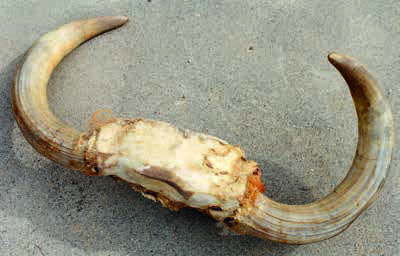
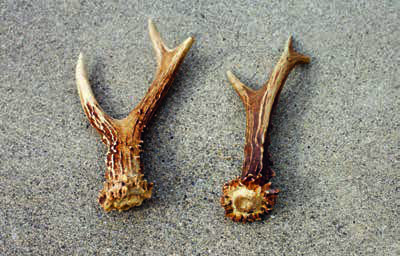
Above: The horns of a bull slaughtered at the age of 14 years. Below: Discarded antlers of two roebucks.
Conclusion: While the bull shows strength through his build (in the front), the cow's strength lies in her internal functions (towards the rear).
The horn is not an antler
Horns differ from antlers in both composition and the way they are formed:
-
The horn is a condensed protrusion of the skin. The bone grows into it forming a bony core that is penetrated by blood cells, furnished with nerves and containing internal air spaces that develop and connect with the sinus cavities. The horns continue to grow throughout life.
-
The antler is a piece of bare and dead bone material that is at first covered with living skin as it grows and develops but then withers and rubs off. The antlers are discarded and are grown anew - somewhat larger each time - every year.
-
The Giraffe is unique among ruminants in already forming its horns before it is born. They consist of loose, skin covered bones that fold back during birth and only later grow firmly fixed into the skull. They remain covered in skin and continue to grow throughout life.
-
The «horn» of a rhinoceros is actually a skin growth which like hair or finger nails contain neither blood cells nor nerves.
Horn development in the embryo and in the young animal
Embryonic development begins with the fertilised egg cell. First of all the amniotic membranes typical of the genus begin to develop, the actual embryo will differentiate itself from them later. Through the navel cord it remains connected with the membranes surrounding the foetus (embryo with its complete organ system) and its mother until birth.
The head and beginnings of the initial five-fingered limbs are present in the 5 week old and roughly 2 cm long embryo. At the end of the second month all the future organs (including the four stomachs) are present in latent form, the fingers and toes have been reduced to two and the hooves can already be recognised even though they are initially made up of very soft, watery tissues.
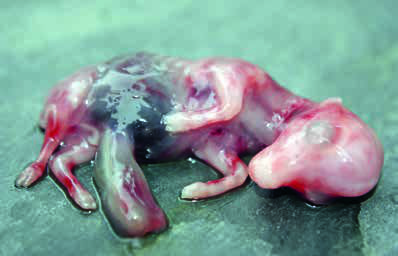
Embryo, five months old.
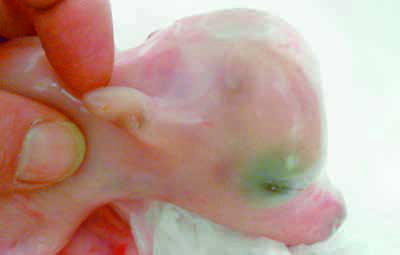
A slight protrusion can be seen on the right hand side of this five month old embryo skull. This is where the horn will later develop.
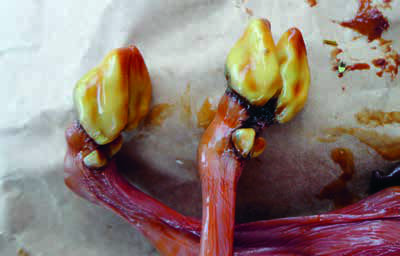
Limbs of a calf foetus that was aborted during the fourth month of pregnancy. During the fourth month of pregnancy the consistency and colour of the hooves and dewclaws change; they become yellowish and set significantly apart from the leg tissue.
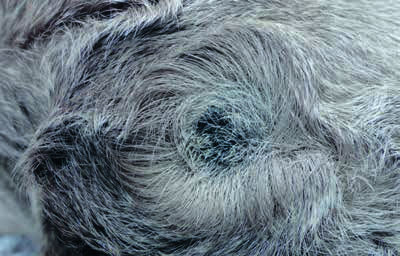
With new born calves there is a small patch of hairless, strongly pigmented skin which is slightly thicker and has a certain shine to it. This is where the horns are to develop. It is well hidden and often surrounded by a small rosette of hair.
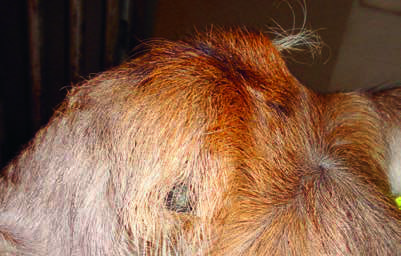
After several weeks when the calf is already starting to eat grass or hay, the horny place gets larger and begins to grow upwards.
When the nascent horn of a several weeks old calf is about one centimeter high, it can be held between two fingers and moved back and forth a little on the skull bone. It is a structure connected with the skin and not the skull. Later on, the bones of the forehead grow out into these small horny sheaths from beneath. The bony core of the horns is at first cartilaginous in nature and only later becomes solid bone fixed to the skull.
The constellations occurring at conception and at birth play a role in the formation of horns. A strong exposure produces lighter and longer horns. - Peter Mika, farmer
When the moon is in Aries at conception, the animal's horns will tend to grow strongly upwards and become long. - Hans Oswald, farmer
From about 12 months of age the paranasal sinus cavities begin to develop in the skull of the calf. They are connected directly or indirectly with the nasal cavity and are covered with the same mucous membrane. The sense of smell however is only located in the rear and upper part of the nasal cavity. The older the animal becomes, the further do the sinuses reach into the bony cores of the horn making them ever more hollow.
In the fully grown cow the sinus cavities fill the entire space in various compartments between the roof of the skull and the brain capsule. The hollow horn bone is the only bone that continues growing throughout the cow's life and of course the horn grows with it.
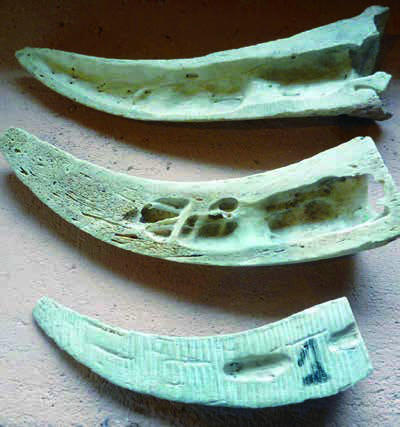
Horn bones from slaughtered cows of various ages cut lengthwise (from bottom to top): bottom - young cow; middle - cow of medium age; above - old cow.
The hooves of a newborn calf are unlike their horns, already fully formed. They end in a pointed somewhat spiral-shaped capping of very soft horn substance and look a little like crumpled horns. This soft capping at the end of the limbs is the oldest tissue present. The younger it is the harder the horn substance becomes (towards the edge of the hoof rim). The soft hoof tips rub off aslant and crumble as soon as the calf stands on its feet for the first time. The hooves retain their accustomed form.
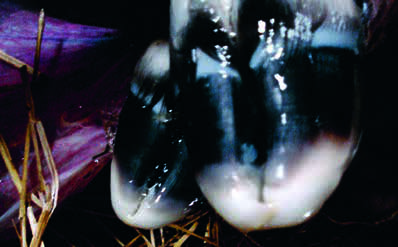
The hooves of a calf at the moment of birth. Notice the small crumpled tips.
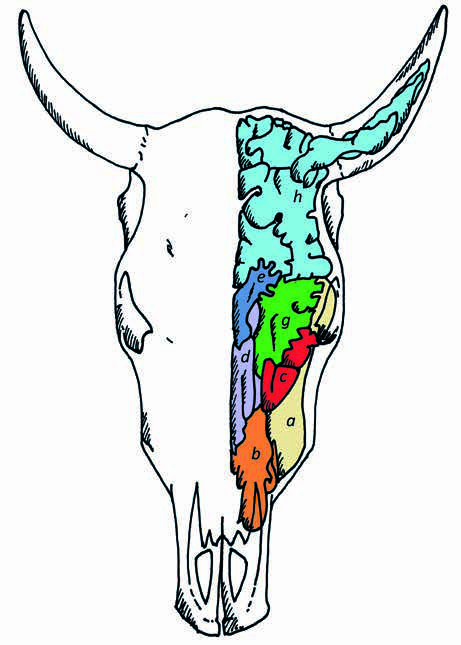
Model of the paranasal cavities on the left hand side of a cow yellow (a): jaw cavity; orange (b): palate cavity; red (c): lacrimal cavity; violet (d): upper nasal concha; dark blue, light blue and green frontal sinus cavity. The ethmoidal and sphenoidal cavities are not visible from above.
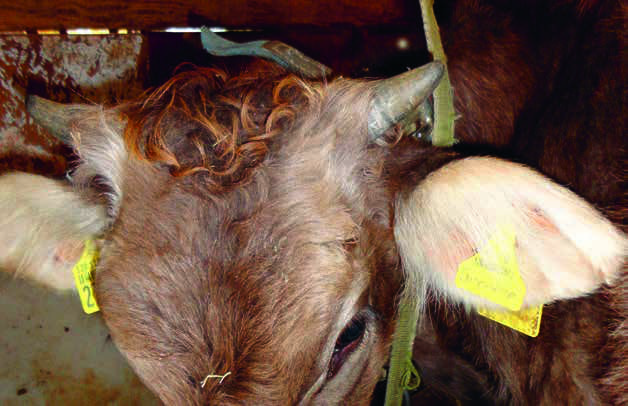
The 12 month old calf has already developed a large rumen capacity and can thrive on low nutrient roughage. The bones in the horn now become increasingly hollow.
If the young animals bump into something with their horns their direction of growth can be altered. If this happens during puberty it can easily lead to deformed horns. I never wanted to use cow horn trainers. Now however I always provide the young animals with wooden horn trainers for about three weeks when the horns are about 10 cm long at an age of around 7-8 months. Then I take them off again and the horns develop beautifully. - Christian Müller, farmer
The horns and hooves of adult animals
The bony core is the innermost part of the horn. It consists of bone material and is firmly attached to the frontal bone of the skull. It is cone shaped and has rough longitudinal furrows on its outer surface. This increases the surface area and ensures a good connection between the horn and bony core.
The diameter of the bony core is greater where it is covered by the horny casing but it has a somewhat narrower neck at its base. Large blood vessels find entry into the bone at this transition point.
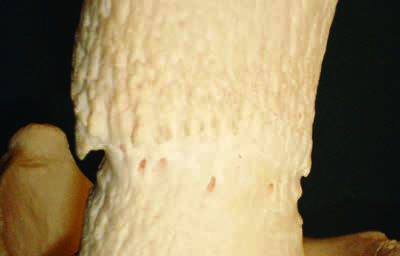
The narrow band at the neck of the bony core is clearly visible.
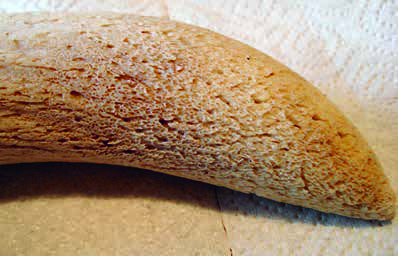
The living tip of the bony core where most of the growth occurs, has a sponge-like structure and in the living animal is well supplied with blood.
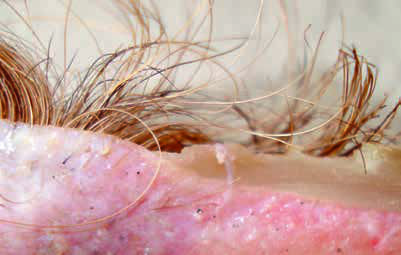
The longitudinal slice through the horn root of a newly slaughtered animal showing the transition from hair-covered skin to horn. Root is to the left, horn tip to the right.
If the horns are thick near the base and become thin and frayed towards the tip, it is a sign that the animal has suffered a mineral deficiency in its youth. - Hans Oswald, farmer
Inside the bony core is a network of airy sinus cavities. With increasing age they extend almost to the end of the bony core and are lined with a fine layer of mucous membranes. The air flows through them with each breath inhaled through the nose. Since a cow's breath is always mixed with the gases escaping from the rumen (the cow belches once or twice each minute) the odour of the rumen reaches right into the cavities of the bony core. This smell can be experienced when a horn is amputated or if a cow suffers an open wound to its horn bone.
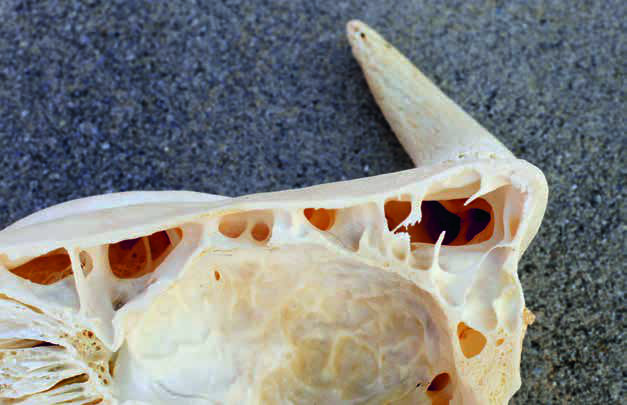
A longitudinal section through the upper part of a cow skull showing the frontal cavity and brain capsule of a cow from inside.
If one puts the open end of a horn to one's ear and then scratches its tip the «gramophone» effect can be experienced. The cow grinds with its teeth when chewing the cud. She hears it too. She is listening into herself. The cow perceives something of its own activity. - Andreas Letsch, farmer
Structure of the horn
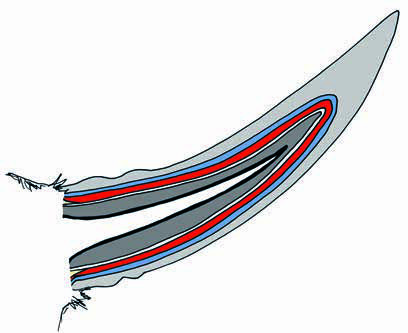
| Label | Description |
|---|---|
| a | Frontal sinus cavity |
| b | Mucosal lining of sinus cavity |
| c | Bony core – frontal bone extension |
| d | Bone membrane – Periosteum |
| e | Subcutis layer – Hypodermis |
| f | Dermis |
| g | Basal layer of epidermis – Stratum germanitivum |
| h | Horn layer / horny casing – Corneum |
| i | Compact horn tip |
| k | Hair-covered horn base |
| l | Hair |
| m | Horn rings |
Exposed dermis after the horn and epidermis have been removed
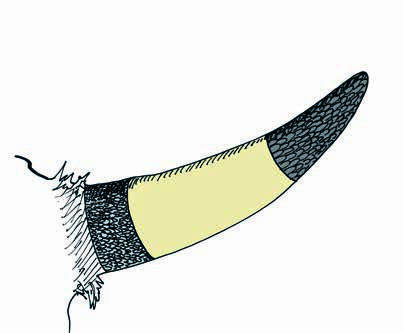
| Label | Description |
|---|---|
| a | Narrow basal strip with fine villi |
| b | Middle zone, with hardly any villi |
| c | Area round the tip with relatively large villi |
| d | Hair-covered skin at the base of the horn |
There is the legendary horn of plenty which always provides, creating much from very little. - Andreas Letsch, farmer
The skin which surrounds the entire animal including the bones of its skull, becomes very specialised around the horns: Instead of producing tough exfoliating surface cells the epidermis forms dense horny tubules that are held together with filler horn. The smaller and larger villi formed in the vascular layer of the dermis beneath it, form the basis of the developing horn tubules. The dermis supplies the epidermis with nourishment and therefore contains blood and lymphatic cells and on the external surfaces of the body also nerves, hair follicles, sweat and sebaceous glands, muscles and connective tissue. Apart from a small amount of connective tissue, the subcutis layer disappears in the vicinity of the horn and becomes almost one with the periosteum of the core. The subcutis layer is loose and mobile throughout the animal so as not to hinder its muscle movements and the stretching and bending of its limbs.
The horny casing is the outermost covering of the horn. It fits exactly over its inner bony core but extends beyond it towards the tip (5-15 cm in cows, with young animals and bulls significantly less). The spiraling curvature of the horn is usually more visible in the casing than it is in the bony core, particularly in older cows.
The horn material is thick and compact towards the tip especially in the case of cows. The tip itself is the oldest part of the horn having been formed when the cow was still a calf.
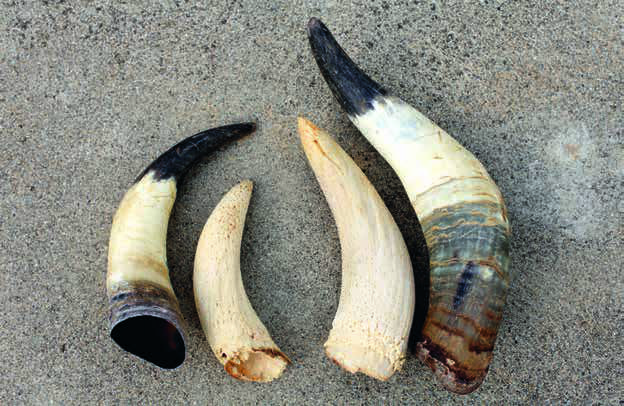
Horns and their bony cores from a young animal (left) and an older one (right). The horn of the older cow is more strongly spiralling.
«Life always seeks to move in curves», says Goethe. Animals in my herd which faced problems in their development and hence had less vitality, have straight horns. - Hermann Lutke Schipholt, farmer
In the central portion of the horn the material is fairly even in thickness and its surface generally smooth. This part of the horn was developed when the animal was between 11/2 and 21/2 years old.
The wall of the horn grows ever thinner towards its base. The lowest part has a rougher surface and is marked by fairly regular rings. These are the so-called horn rings. There are no such indentations on the horn's inner side.
The irregular surface structure of the horn has a connection with - amongst other things - the number of pregnancies the animal has had. The number of horn rings indicates how many calves a cow has given birth to. It is probably the case that the growing calf needs so much energy (and substance) that there is less available for developing new horn substance. If they are allowed to grow old enough, bulls will also develop rings around the base of their horns. The formation of rings could therefore also be influenced by the seasons or the kind of fodder they are offered. ^1
If I feed straw to the cows when they are dry, their horn rings become more pronounced. A cow's biography can be read in its horns much like a tree in its trunk. - Peter Mika, farmer
The skin within the horn is continually creating new horn substance and pushing it outwards and upwards. The seam marking the transition between the skin of the head and the horn is where the outer horn layer begins. The amount of horn substance created determines the thickness of the horn along its length. At its tip the horn substance contributes to its compact solidity. At no point are there any hollow spaces between bones, the horn creating membranes and the horn itself.
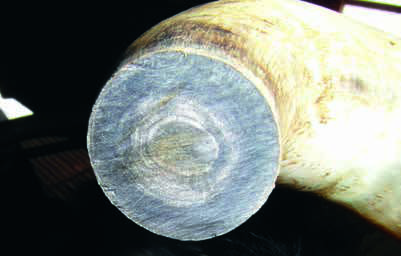
The cross-section of a horn tip shows a structure of concentric circles.
The functional structure and age of the cow can be associated with the three parts of the horn. In the calf the nerve-sense function predominates (inquisitiveness, wakefulness, playfulness). The black part of the horn develops during this time. At the age of one year to two and a half years the animal's breathing and circulatory organs are being developed alongside its metabolism. That is why a spell up in the mountains is so good for them.
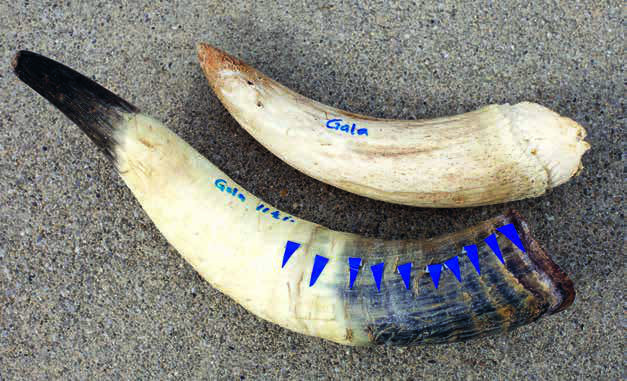
Horn rings on a 12 year old cow.
If the distances between the successive rings of a harmonic spiral are measured their relationship is approximately 8:5:3:2:1 - which is the ratio of the golden mean. The horn always has the tendency to spiral. The same can be seen with the hooves of newborn calves - they are slightly twisted. The hoof tips also curve at the front if they grow too long. - Andreas Letsch, farmer
This is when the middle portions of the horns are being developed. When the adult cow's main focus becomes metabolism, digestion and reproduction the basal section of the horn develops and continues to evolve as the cow grows older. The compacted horn tip also grows longer due to the bony core growing more slowly than its horny sheath.
^1 According to scientific literature, available from the authors.
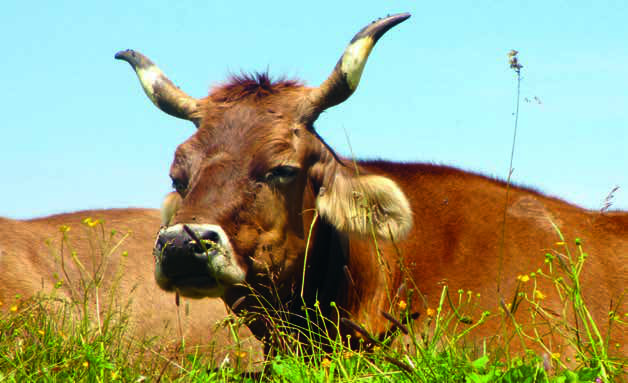
The three parts of the horn are particularly well pronounced in the Swiss Brown cattle: The tip is mostly black, the middle section white (darker on the inside) and the basal section has brown-grey colouration.
Bulls have much more powerful heads than cows. That is why the diameter of their horns is greater. The bony core is particularly strongly formed and as with the cow, it contains large cavities. The horn casing however is rather thin in comparison. What is especially striking is that the bony core extends almost to the tip and there is only a short section of compacted horn.
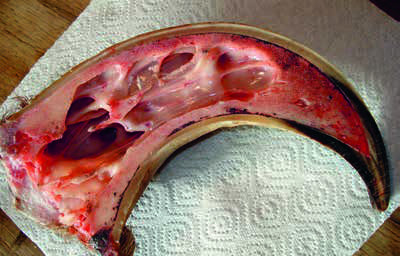
The horn of a freshly slaughtered young bull sliced in two.
The hooves
The hooves of ungulates are also composed of horn substance. They form the twofold endings on each of the cow's limbs (corresponding to the human middle and ring fingers).
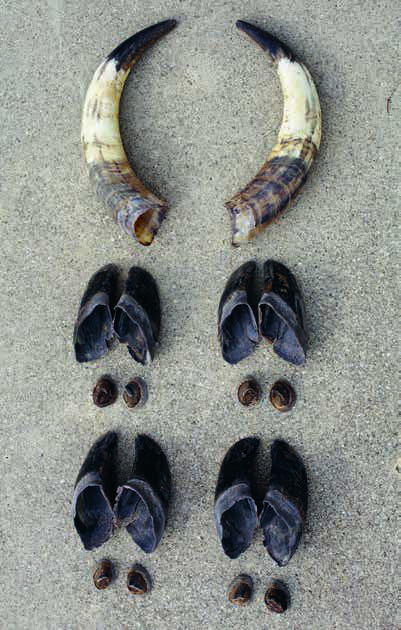
A cow's 18 horned extremities.
They are structured in a similar way to the horns:
-
The bone of the hoof - the last bone of the limb - is in the centre. Unlike in the horn however this bone is not hollow but solid.
-
The hoof bone is connected via a joint to the middle phalanx (os coronale) lying immediately above it. The attached muscles and tendons give mobility to the foot. The tip of the foot is protected by the horny shoe and is so tightly bound to the hoof bone and its dermic membrane that the animal's bodyweight is distributed evenly across the whole foot.
-
Horn forms on the sides and base of the foot. It grows from above downwards and is continually being worn away through walking. If this doesn't occur either naturally or with the help of a hoof knife, the tendency to grow in a spiral form becomes visible just as it does with the horns.
-
Just below each ankle joint are two dewclaws. These are remnants of the second and fifth toes which ceased growing during the phase of embryonic development. Although far smaller than the hooves of the third and fourth toes, they are nonetheless formed in exactly the same way and are likewise encased in horn material.
Horn as a material
Horn is formed from the skin. Although «dead» it is produced through a living process (similar to that of tree bark). The main constituents of horn are the various keratins - fibrous, sulphur-containing proteins. Keratin is found on the surface of skin in the form of skin callus and dandruff, in hair, wool, feathers, bristles, spines, hooves, claws, horns, nails, beaks, baleen (whalebone), tortoise shell and also in silk and spider webs.
Horn is often used as a fertilizer in the form of horn meal or horn shavings thanks to its high nitrogen content of 12% to 15%. It was used in earlier times as a valuable material for making buttons, combs, pipe ends and handles. Because it is easy to work when warmed and softened in water and can be sawn, split, pressed together, drilled into, turned on a lathe and even welded into sheets, the light, translucent horn material was even used for making lanterns and apothecary scales.
If a horn or a hoof is removed when a cow is slaughtered and left around, it will dry out and become very hard. While part of the living animal the material is moist, soft, malleable and easily cut.
The functions of horns
Distinguishing characteristics
Their horns allow cattle to attain a stature beyond the compactness of their bodies. The cow's silhouette has character through its horns. Since a cow's capacity for clear vision is limited to about 10 metres within a 60° viewing frame, anything further away will only be perceived in terms of outline and movement.
Cows which have been dehorned as calves generally have eyes set closer together than those with horns. ^1 They therefore tend to focus more strongly in a forward direction and have a somewhat larger blind spot towards the rear than horned cows.
The horn is a manifestation of the animal's biography. Physical and soul qualities are expressed in the form. The character of the animal is perceived by the others at least in part through its horns. Horns bequeath a higher status on the cow, she receives more respect. - Christian Müller, farmer
Holding their own place in the herd's hierarchy
Whoever spends time watching cows grazing will soon become aware of the individual relationship between one cow and another - friendly but also respectful of hierarchy. In every herd there is a hierarchy acknowledged by each of its members. Their position in it however must continually be reasserted. The hierarchy shows itself in the dominating behaviour of animals higher up the scale and the evasive behaviour of those lower down but also in the struggles going on between them.
The domineering behaviour is more antipathetic. We see more friendly connections when the animals are grazing and resting or when they lick one another. When trying to keep flies away they are happy to be close and often stand head to tail with one another. Both kinds of behaviour may be displayed by the same animals at different moments in time.
Our herd went through phases of having beautiful horns and other times when they were less so. Cows with beautiful horns tend to occupy a higher position in the herd and therefore have it easier. - Christian Müller, farmer
^1 According to scientific literature, available from the authors.
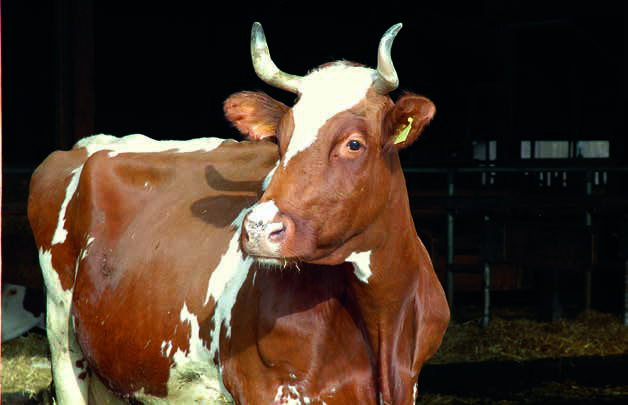
Cows recognise one another at a distance through their silhouette. We can also most easily recognise our cows by their horns.
Horns give the animals serenity, inner contentment and also security. - Hans Oswald, farmer
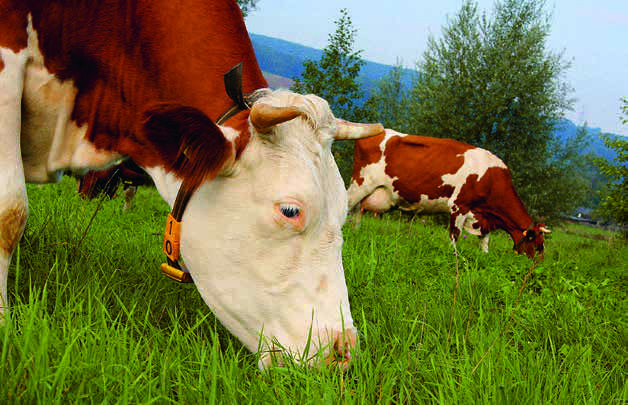
The individual distance of each cow varies according to its position in the herd. Cows are able to maintain their individual distances out on the field without any problem. Hence rivalry is far less frequent than when they are housed.
Less immediately apparent but nonetheless influenced by the hierarchy or pecking order, is the distance held between one cow and another. The amount of space needed by each animal is strongly affected by whether it has horns or not. Among horned cattle, the required distance between animals higher up and those lower down the hierarchy ranges from one to three meters. Hornless animals by contrast need one meter at most. This space surrounding each animal like an invisible bubble is known as its «individual distance». Encroachment into this space will either lead animals lower down the hierarchy to flee or set the scene for a struggle. Horned animals of the same age are almost always higher up the ladder than those that are dehorned. Older animals are normally higher up than younger ones.
Problems very rarely arise between horned cattle out on the pasture. In loose housed conditions however struggles and fights among horned cattle can be quite frequent especially if space is tight. This leads to stress and a higher risk of injury. Serious injuries caused by the horns can occur particularly to the udder and vagina. However even in more confined conditions it is possible to have a peaceful herd of horned cows. A good relationship to the cows and minimal changes in population brings peace to the herd. ^1
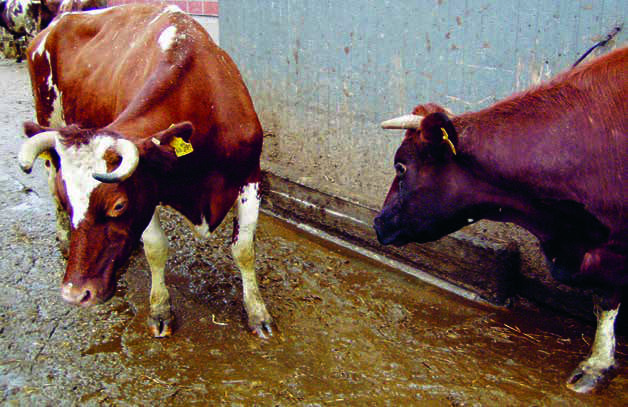
A conflict situation in the barn: The cow on the right is threatening the one on the left which has to give way. The individual distance of horned cattle is between one and three times greater than that of cows without horns.
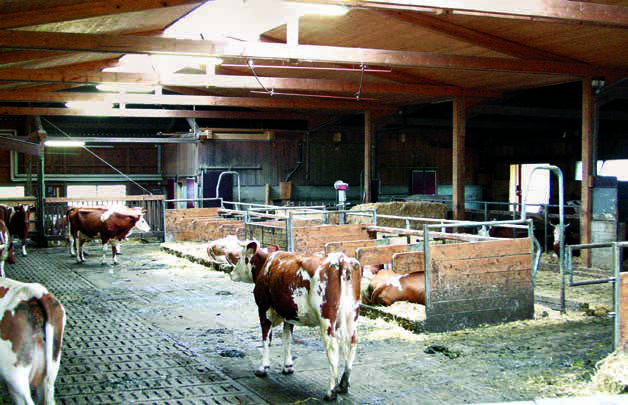
Loose housing that allows sufficient space for giving way. The field is imitated in a species appropriate way.
If I have animals with harmonious horns my herd is at peace. - Peter Mika, farmer
Dehorned cattle are generally quieter under loose housed conditions than horned ones, largely because their individual distance is smaller. Frequent injuries caused by head butting though less outwardly visible, can occur among dehorned cows too.
In order to avoid having a fight animals in confined housing conditions often don't move very much. It was observed how in an average sized loose housing situation the animals moved about for less than 2% of the day, while out on the pasture they would spend 12-15% of the day in movement. While cows at pasture will cover some 4 to 10km per day, those indoors rarely exceed 0,3 to 4 km. ^1
When struggles do occur between animals the horns are used to hold or deflect an attack. They are then frequently used to hold their heads together, prevent them slipping off and to allow a head to head trial of strength to take place. The horns do not then have a «weapon» function.
Hornless animals are not able to push against one another; they slip off and must tackle each other from the side. They cannot conduct their struggle in a species specific way.
The young males are particularly keen on playfully locking horns together - they hold on and rub forehead on forehead or move their as yet small horns against one another. ^1 Adult animals also enjoy a friendly, playful locking of horns or mutual scratching with them.
With their horns cows exhibit quite specific grooming behaviour - using them for instance to scratch their backs. Or when they use the horn tip of another cow to scratch and clean their own eyes. ^1 Each animal is acutely aware of the size and form of its horns and where they end. This also gives it a sense of its place in the herd. ^1
^1 According to scientific literature, available from the authors.
Cows whose horns grow downwards tend to be depressive. Cows with outward stretching horns tend to be more rebellious. Cows with horns that grow upwards are neither aggressive nor are they molested. I have twins - with one the horns grow upwards and with the other downwards. Already as a youngster the animal with upward growing horns was more lively and now produces more milk. - Christian Müller
Digestion and metabolism
Since all horn bearing animals are ruminants we may assume there to be a connection between their highly developed digestive organs and their horns. Very little research is however available on this. In the Agriculture Course Rudolf Steiner describes such a link (see quote below). Since then many biodynamic farmers have tried to make their own observations regarding the connection between horns and metabolism.
If a cow's horn smells strongly it means that something is wrong with her. There is a link between the horn's smell and the metabolism. The horn has a sweet siliceous, somewhat spicy smell. There is no other smell like it. - Christian Müller, farmer
The cow accomplishes quite a feat through its digestive process. Up until now no artificial means have been found to transform cellulose material into something useful to human beings with such little energy and cost. The ruminants' digestive organs are totally focused on the transformation of cellulose. The 'normal' digestive tract - mouth-gullet- stomach-duodenum-small intestine-appendix-large intestine-rectum - is formed in such a way that the three fore stomachs created from the gullet during embryonic development, are placed ahead of the small intestine, the main organ of absorption. The entire mass of pre-digested cellulose material along with the bacteria, yeasts and microbes living in the rumen are digested in the abomasum and small intestine and provide an important source of protein. This only occurs with ruminants. With all other species that consume cellulose such as horses and rabbits, the material passes through the small intestine and is broken down by micro-organisms living in the large intestine and produces a poorer quality end product.
With ruminants the most important processes of metabolism - rumination and the fermentation of cellulose - occur in the foremost part of the organism, in that part of the body where in most animals sense activity predominates. The frontal weighting of the body and the horns help to limit this «forward moving power». This is emphasised by the fact that the growth of the horns is in the form of an inward curving spiral focused round a central point.
These digestive processes enable the animals to produce milk including some for human consumption and fertilizer for growing plants, which advances humus formation and benefits the landscape. They give birth to a calf each year almost as a matter of course and in the end provide us with meat. This level of performance can only be achieved through the cow's organism.
To this belongs the characteristic quality of a cow's life - they spend two thirds of each day either eating or ruminating. Their senses are not outwardly awake but are directed inward into their own bodies. They often appear to doze while ruminating. At the same time their head is held attentively upward but focused inwardly. While chewing the cud they are performing a metabolic activity 'consciously' in the head, something which other animals and humans only do when taking in food. Ruminants actively decide when they want to start ruminating and deliberately break off doing so, if they get disturbed.
During the process of rumination the chewed material or cud moves back and forth between the dark, anaerobic, slightly acidic milieu of the rumen and the lighter, more oxygen rich, alkaline milieu of the mouth. ^1 This is not only about the moving and transforming of substances, it also concerns forces. The horn is able to hold back the forces escaping from the processes of digestion and redirect them back into the animal's organism. This recycling and concentrating activity is what contributes to the enormous metabolic capacity of the bovine animal. The function of the horns (and also the hooves) in relation to digestion and metabolism has therefore more to do with forces than with substances.
^1 According to scientific literature, available from the authors.
Have you ever wondered why cows have horns ...? It is a most important question. ... I have just mentioned that everything organic, everything living does not always need to have streams of forces that are only directed outwards but also streams of forces flowing inwards. ... What happens in the places where the hooves and the horns are growing? A locality is created where the inflowing stream of forces is particularly strong. The outside is strongly closed off. No longer is there any communication through permeable skin or hair, the gateway for that which seeks to stream outwards is completely closed. The formation of horns is in this way intimately connected with the whole form of the animal. ... The cow has horns so that it can send into itself the formative astral-etheric principle, that it can penetrate and stream into the digestive organism. What radiates from the horns and hooves can then work strongly into the metabolic processes. - Rudolf Steiner, Agriculture Course, lecture 4
Breathing
The nose and mouth are two openings through which the cow comes in contact with the outside world. Each breath brings external air into the nose. Its mucus membrane warms and moistens it. Any particulates collect on the moist surfaces and are subsequently expelled. The cow's very large paranasal sinuses increase the area of mucus membrane and in extending right into the horn's bony core, form a significant part of the immune defence of the breathing system.
With the in-breath air from the sinuses is carried on the breath and drawn into the lungs, lowering pressure in the sinuses at the same time. With the out-breath air from the lungs passes through the nose together with rumen gases rising from the throat, enters and increases pressure in the sinus system.
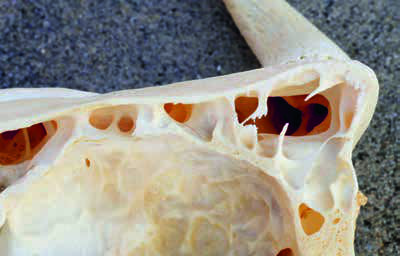
The paranasal sinuses reach right into the horn.
In breathing in and breathing out the air passes over that zone of the nasal mucus membrane where the olfactory receptors are located. This is where the smells carried on the in and out breath are perceived.
Disbudding and dehorning
Apart from the risk posed to farm personnel, it is the changeover from tethered to loose housing that brought the issue of horns into sharp focus. The recommended and permitted dimensions of the loose housing are usually so tight that cows are unable to avoid one another and often end up in fights. Since this leads to frequent injuries among the animals, the dehorning of loose housed cattle came to be recommended.
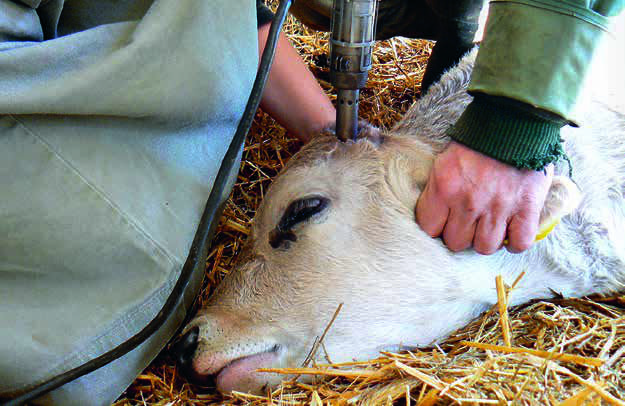
Disbudding is painful for the calf.
Cows that push others around often have the tips of their horns removed. I have found however that these cows never produce as much milk as they did before. The removal of horn tips probably leads to a loss of orientation. - Hans Oswald, farmer
In emergency situations when the injuries can no longer be tolerated, even the horns of adult cows are removed. During the 1970s and 1980s when loose housing was being introduced, it was common practice for the horns to be sawn off under anaesthetic using thick steel wire. The bleeding veins were sealed and the sinus cavities plugged with a tampon. In time the wound gradually closed. Sometimes a horn stump would re-grow.
This form of dehorning is rarely practised today. It is now usual to disbud calves before they are four weeks old. In Switzerland disbudding with a searing iron (700C) must be carried out under local anaesthetic by trained professionals and cause as little stress as possible. In Germany the disbudding of calves is permitted up to the age of six weeks. In the United Kingdom calves have to be disbudded within the first two months of life, under local anaesthetic by a trained person.
The intervention is painful. The calf can feel the pain for two or three days after the anaesthetic has worn off or even longer. The wounds however heal rapidly.
The removal of the horn structure has a noticeable influence on the form of the developing skull. On attaining adulthood most of the dehorned animals will have developed a marked bulge on their foreheads.
If we look at the interior of a bony skull we find that this bulge - like the horn's bony core - is filled with air spaces. The animals probably need a certain volume of sinus cavities and have to compensate for the lack of horns to develop this bony protruberance.
If an animal loses a horn casing as a result of an accident, it can grow a new one. The younger the animal the better it grows. - Rochus Schmid and Martin Bigler, farmers
An examination of more than 230 skinned cattle skulls immediately after slaughter reveals that a high proportion of the skulls of dehorned animals have a bulging forehead.
In addition, the frontal bones of dehorned animals were more concave in shape, were drawn forward and there was a smaller distance between the eyes. Animals with horns generally had flat (especially towards the top) or slightly arched frontal bones and a wider distance between the eyes. ^1
^1 According to scientific literature, available from the authors.
Animals with pointed horns often have a prickly («pointed») nature. They can rapidly and without warning cause injury to the others. The cow and the herd will be more docile if their horn tips are sawn off. Not much is achieved by attaching a block or ball to the horns since by making them larger the cow will likely seem even more dominant. - Andi Wälle, farmer
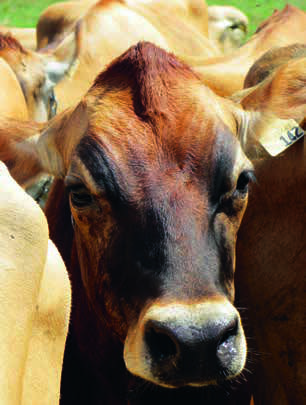
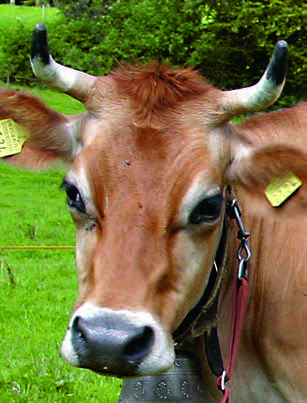
Dehorned and horned Jersey cow. The protruding forehead is clearly visible on the dehorned cow.
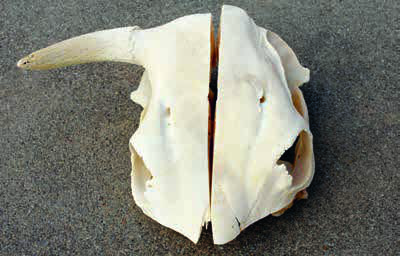
Half of a skull of a cow with horns (left) and that of a cow dehorned as a calf (right).
The fact that the animal organism reacts to the removal of a few square centimeters of skin with such a big change in skull development, indicates that cattle really need their horns and have to compensate by transforming their frontal bones.
Breeding hornless animals
To avoid the intervention needed to prevent the growth of horns on individual animals, more and more effort is being made to breed genetically hornless animals. By this means the animals are spared a great deal of stress and pain as well as saving both time and money.
In breeding hornless animals however no account is taken of what horns actually mean to the cow. As has been described the horns form an essential part of their whole ruminant nature.
Breeding for hornlessness is an intervention on a higher level since not only the individual animal but the entire breed is affected. Once a breed has become hornless which is not hard to achieve since hornlessness is a dominant trait, it can no longer be reversed in that breed. We don't know the consequences of this.
In the case of goats which have been bred to have no horns fertility problems can occur if an animal inherits the hornless gene (homozygote) from both father and mother. This problem is unknown with cattle and sheep. But in older hornless bulls cork screw penisses occur much more often than in horned breeds. This spiral deviation of the penis occurs as the bull attempts to serve, therefore service is virtually impossible. In a Canadian study cork screw penises were the culling reason in 25 % of 5 year old hornless bulls.
There are hornless breeds which have been managed and bred without any problem for hundreds of years. We do not however know what it feels like for the animals themselves.
Encourage trust between humans and animals
A survey of farmers has shown that those with dehorned animals see horns as being dangerous. ^1 Those who keep horned animals do not as a rule find the horns dangerous. Dealing with horned cattle demands a greater sense of awareness and focus than with hornless ones because their head area and operating range is greater.
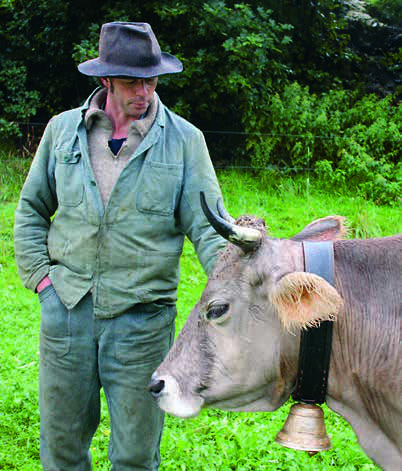
Working with the animals in an attentive and respectful way leads to mutual respect. This is the basis of a good injury-free working relationship.
We must take care when tethering cows with horns, to stand behind and somewhat aslant the head and close up against the animal. When leading them however, a stretched out arm is helpful.
If trust has been developed from birth on between man and animal, the animal will never deliberately injure a person with its horns. Accidents can nevertheless occur if the animal's head region is approached without due care, we don't take account of its movements or intentions, or if due to fear or shock, it behaves differently. Mutual trust between human and animal is the best guarantee for a good and injury-free relationship. Suggestions for handling cattle in a stress-free way can be found in a FiBL guide on successful cattle handling (available in German and French).
^1 According to scientific literature, available from the authors.
The developmental, physiological and behavioural phenomena described in this brochure clearly show the importance of horns for cows and other ruminants. A clear recommendation arising from this - for the organic movement and beyond - is that horns need to be retained.
Imprint
Publishers:
- Research Institute of Organic Agriculture FiBL
- The Biodynamic Association UK
- Bio Dynamic Farming and Gardening Association
- Bio-dynamic Association of India (BDAI)
Authors: Anet Spengler Neff (FiBL), Beatrice Hurni and Ricco Streiff in collaboration with the cattle breeding group of the Swiss Biodynamic Association with Martin Bigler, Robert Haeni, Mechthild Knösel, Andreas Letsch, Thomas Loeffler, Herman Lutke Schipholt, Alexandra Mayer, Peter Mika, Christian Müller, Dorothee Müller, Hans Oswald, Rochus Schmid, Urs Sperling, Heinrich Till, Andi Wälle and Silvia Ivemeyer (University of Kassel)